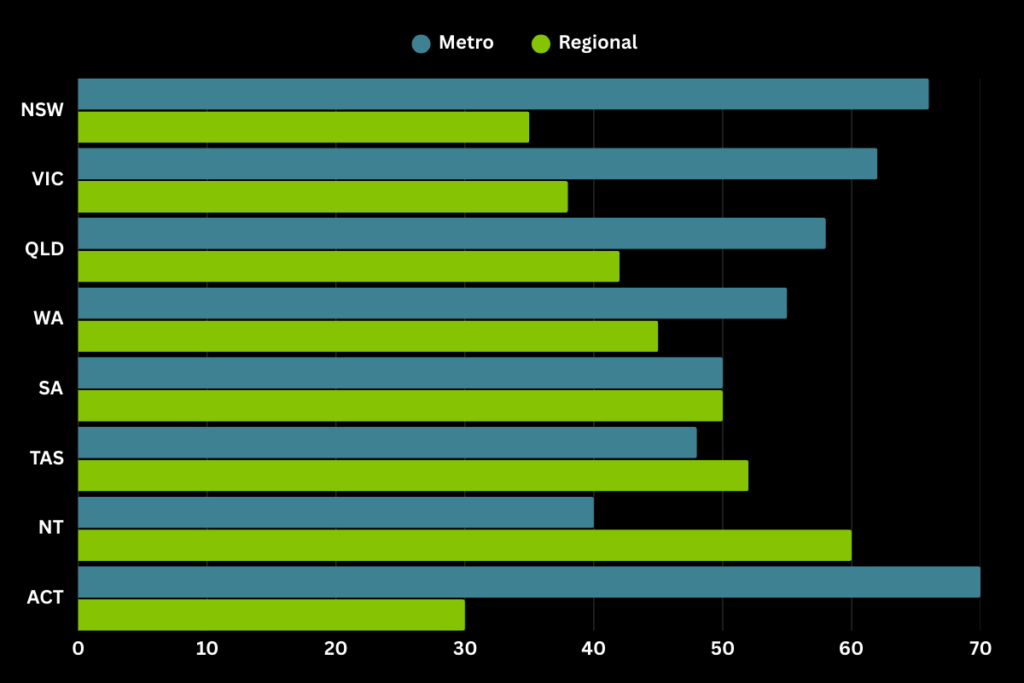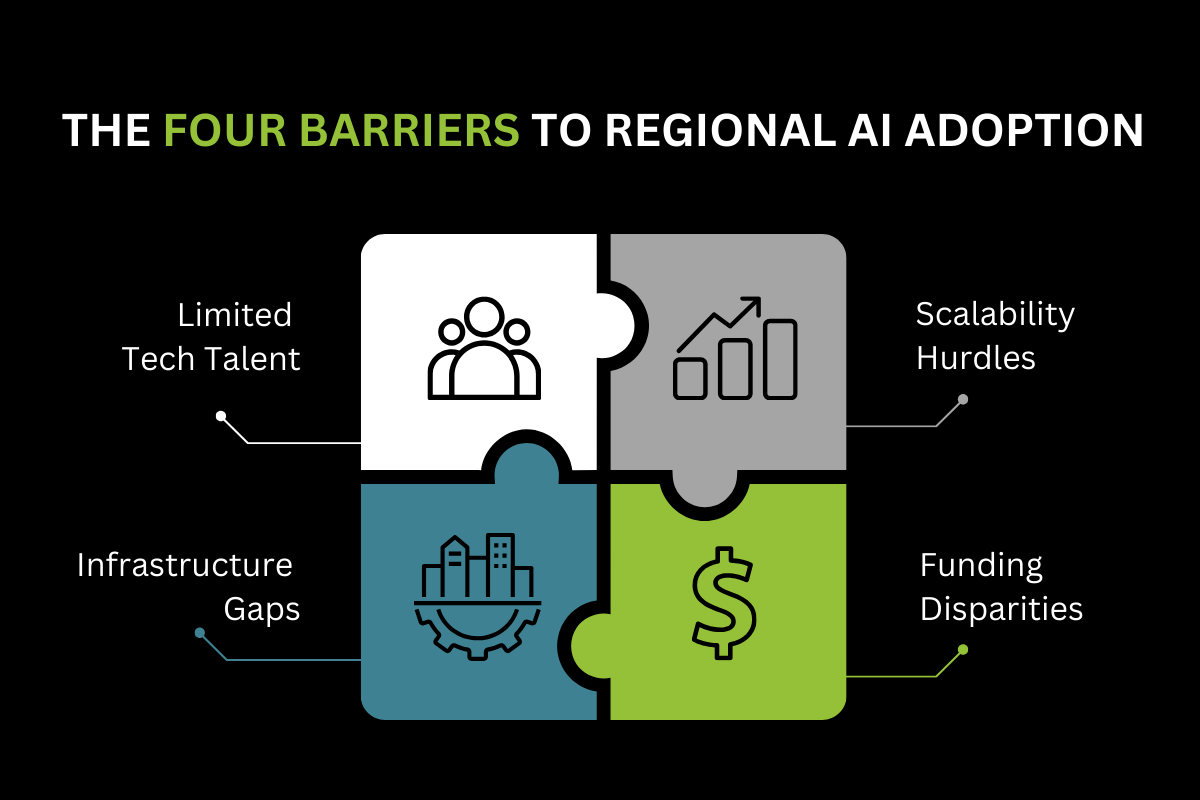While metropolitan businesses rapidly adopt artificial intelligence (AI) and automation, regional small and medium-sized enterprises (SMEs) often find themselves working with outdated tools, facing limited funding options, and struggling with talent shortages. However, the tide is turning—AI is no longer reserved for tech giants with massive budgets and specialized teams.

Metro vs. regional AI adoption rates
At Hello World AI, we believe regional Australian businesses have a unique advantage when leveraging AI solutions—one that their metro counterparts often lack: deep community knowledge, operational agility, and the ability to implement targeted solutions without excessive bureaucracy.
The Challenge: Regional Businesses at a Digital Disadvantage

Regional SMEs encounter four major barriers contributing to the tech divide:
1. Limited Access to Tech Talent
Metropolitan areas naturally attract clusters of tech professionals, making it difficult for regional businesses to recruit AI engineers and data scientists. This talent gap limits AI adoption and digital transformation opportunities.
2. Funding Disparities

Venture capital (VC) investment in Australia is heavily concentrated in three states:
- New South Wales: Over $10 billion in VC funding (2019–2024)
- Victoria: $4.7 billion in the same period
- Queensland: $2.3 billion
These three states collectively account for over 90% of VC raised by Australian startups between 2019 and 2024, leaving regional businesses at a major funding disadvantage .
3. Infrastructure Gaps
Many regional areas still contend with:
- Inconsistent high-speed internet connectivity
- Limited access to cloud computing services
- Fewer AI and technology service providers
These infrastructure barriers slow digital adoption and limit the ability of regional SMEs to integrate AI into their operations.
4. Scalability Hurdles
Without access to the same AI tools and automation platforms as metro-based businesses, regional companies struggle to scale efficiently while maintaining high-quality service delivery.
The result? A growing digital divide that threatens to leave regional businesses behind.
The Solution: AI as the Great Equaliser

AI has evolved dramatically. What was once available only to tech giants is now accessible, affordable, and customisable for businesses of all sizes—including regional SMEs.
How AI is Bridging the Gap for Regional SMEs
Cloud-Based AI Solutions – No need for expensive on-premise infrastructure. AI is now available as a service, meaning businesses can access AI tools with just an internet connection.
No-Code & Low-Code AI Platforms – Businesses can now integrate AI into their workflows without requiring advanced technical expertise or in-house developers.
Flexible, Subscription-Based AI Models – The shift to pay-as-you-grow pricing allows smaller businesses to access enterprise-grade AI without prohibitive costs.
AI-Driven Remote Work Enablement – Businesses can tap into global AI talent and automate routine tasks, improving efficiency without needing local AI specialists.
Success Stories: AI in Action for Regional SMEs

Retail: AI-Driven Inventory & Demand Forecasting
A family-owned retail chain in regional Victoria implemented an AI-powered inventory system, analysing purchasing trends, seasonal demand, and supplier logistics. The results:
- 23% reduction in excess inventory
- 15% increase in profit margins
- 30% improvement in accurate demand forecasting
This technology gave them data-driven decision-making capabilities previously only available to national chains, allowing them to compete on a level playing field.
Agriculture: AI-Optimised Farming
A mid-sized farm in Queensland deployed AI-powered crop monitoring and predictive analytics, transforming their operations:
- 30% less water usage through AI-driven irrigation insights
- 25% decrease in fertiliser costs
- 18% increase in overall crop yields
By using AI for precision agriculture, they achieved sustainability goals while increasing profitability.
Professional Services: AI-Assisted Financial Automation
A regional accounting firm automated document processing and implemented AI-powered financial analysis tools:
- 50% reduction in manual paperwork
- 40% increase in client capacity without hiring more staff
- 3x faster tax return processing
Now, they compete directly with metro-based firms, offering faster, AI-enhanced accounting services.
How Regional SMEs Can Get Started with AI
1. Identify High-Impact AI Opportunities
Time-intensive manual processes slowing down operations?
Untapped business data that could be turned into valuable insights?
Customer service inefficiencies where AI-powered chatbots could help?
 2. Adopt Ready-to-Deploy AI Tools
2. Adopt Ready-to-Deploy AI Tools

3. Leverage Government Support

The Future of AI is Regional
Regional businesses that embrace AI now will outperform metro competitors through:
- Faster, more agile innovation
- Stronger local market insights
- More personalised customer experiences
- AI-driven efficiency improvements
According to the Australian Bureau of Statistics, regional businesses implementing AI grow revenue 27% faster than those that don’t.
Ready to Unlock AI for Your Business?
📩 Book a Free AI Readiness Consultation to:
✔ Find the best AI solutions for your business needs
✔ Get a step-by-step AI adoption roadmap
✔ Access funding & resources to reduce costs
🚀 The AI revolution isn’t just for tech hubs—it’s for regional businesses too. Let’s build the future of regional innovation together.
Sources:
Folklore VC – The State of Australian Startup Funding (2024)
Government of Australia – Regional Digital Connectivity & Business Grants
Australian Bureau of Statistics (ABS) – Business Counts by Location (2023-24)
Reserve Bank of Australia (RBA) – Recent Developments in Small Business Finance and Economic Conditions (2023)
Statista – Share of Total Venture Capital Raised by State and Territory in Australia (2023)
Dealroom – Guide to Australia’s Startup Ecosystem (2024)


Leave A Comment